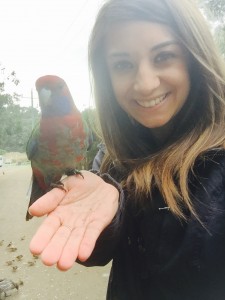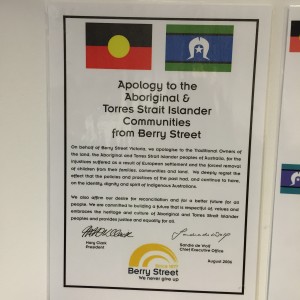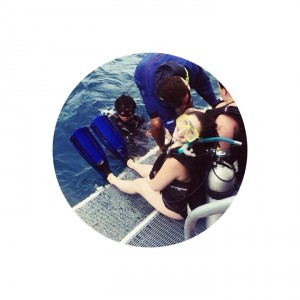Trip Abroad…Learning Experience
Spending three weeks studying abroad can certainly change any individual. After spending twenty-one days in Australia it has completely transformed my life, my perceptions, and how I view the world professionally. While answering questions about my trip to my friends and family, the only thing I can seem to say is: “ I do not know where to even start, I can talk for days.” This was the first time I have ever traveled over seas without my family, and I can certainly say this is the first time I fed kangaroos and meditated in the rain forest. I have met many individuals that I hope to be friends with for a lifetime, and even professionals that I can go to for career or professional advice. This trip was empowering, and incredible to be surrounded by individuals who care so deeply for mental health as I do, and all diverse individuals regardless of their race, orientation, or culture. After an internship at Child Services, I thought I could sum up social welfare or the social work field and agencies pretty well since I am a psychology major, based on my experiences since I have never had a social work class. However, like many others, I was completely wrong and this once in a lifetime opportunity abroad solidified how involved in every aspect of life the mental health professionals are.
I may be able to show pictures of the twelve apostles or the breathtaking views of the beaches, but the agency visits are impossible to describe to anyone. Overall, the entire atmosphere of each agency seemed to be more welcoming and displayed an entire different message than what I have experienced from agencies in America. One thing about Australia’s agencies that stands out is the immense focus on relationships with their young people or clients. Each organization genuinely cared for, and strived towards trying to build up a relationship, which makes an overall positive impact therapeutically on the young people. Trauma moves through the entire system, and this has been one piece of advice that has made an impact on me. I have worked places in youth residential therapeutic settings, and I feel that this approach was not being utilized. The approach that I saw here in my experiences, was not a lot of relationship building with young people, and it is impossible to make positive strives forward therapeutically without a comfortable bond. The main key to recovery is the process of close and comfortable relationships, and Australia has confirmed how important this is, and how well it works in their agencies.
The entire organizational culture is critical in the therapeutic setting. Many workers surround young people, and every relationship in the organization can make a small difference in their therapeutic journey. This is definitely one piece of the trip from the agencies that made a huge impact on my life for the long run. Australia has numerous hard working mental health agencies, and agencies seem to be more prevalent in their communities. They run on an evidence-based framework, and I believe that our country can adopt many of Australia’s practices.
Critical History Lesson…
Australia overall seemed genuinely welcoming to our big group of tourists. However, most cultures may have a deep and saddening history. Before coming to Australia I have heard of Aboriginals, but the only facts that I thought were correct were all myths on their lives or culture. Coincidently not only did I learn about their positive therapeutic relationships they work so hard on in agencies, but I learned of a negative tragic relationship between two people. Their history happened to be undoubtedly heart breaking between the Aboriginals and White individuals. Our first visit at the Victorian Aboriginal Child Care Agency (VACCA) was very informative to my knowledge of the real truth of the Aboriginal people who have a culture of 60,000 years old! These individuals have the longest culture in the world, and discriminated against for years and unfortunately still in many places in Australia, which we witnessed first hand. This is a huge issue in America currently of racism, and this goes to show it truly is seen everywhere in the world and forever present. One day the Aboriginals were run off their land that they have inhabited for years, and presently still fighting oppression. Not only did we get to hear the didgeridoo being played live for us from real Aboriginal men, but also we heard the heartbreaking stories of the Aboriginal women of many generations of racism and oppression who work at the agency presently. These stories were eye opening to an entire culture fighting for a free life, and that many Americans simply do not even know the truth. One piece of information that is critical is the Stolen Generation where thousands of children were stolen from their families and many never seen again. Many of the unique stories of the stolen generation really made our group put our selves in their shoes, especially the visual project. We all lined up together in a line, and slowly we all were ripped apart and spread out all over the room. I cannot imagine being torn apart from my family and never seen again. Just in 2008 an official apology came through for the Aboriginals from the Prime Minister Kevin Rudd. Australia truly is trying to make steps forward to respect the people of the land, and even have signs at each agency respecting the first people of the land. Hopefully our own agencies and country, (as we have had a great week in improving equality to all) can adopt some of the ways the agencies in Australia recognizes the first people of the land.
Professional Growth…
As it is known in the field, psychology and social workers work hand in hand but have such similar jobs that overlap. This can be quite the decision while deciding on what route to go to for graduate school. Currently I am aspiring to become a therapist for children or a psychologist. Social workers and psychologists work in similar settings, and can perform some of the same services for clients. I have always wanted to work with clients who are victims of sexual violence/assault and I learned how easily I could even do this with the social work route. I had the chance to learn about Gatehouse Centre a service inside The Royal Children’s Hospital who works for victims and most were social workers. Before my trip to Australia I mostly thought of social workers working in child services or hospitals only due to my internship experiences. However, after my trip I realize how closely psychologists and social workers work together in many clinics and agencies. They both can be involved in family therapy, and closely work on effective treatment methods together. I was even shocked at how much they resorted to primary caregivers and occupational therapists all working within the field as well together for clients. If all professionals can come together, it can really make a powerful impact on individuals in the community when it comes to mental health. I believe that there needs to be more services or clinics where there are many professions under one roof. Clients may have trouble with transportation, and if there is more services available with many professions together, with the help of guaranteed health care to all and many services working toward genuinely helping all clients no matter the disability or issue our communities can get the therapy they need. I would love to one day work in a clinic where individuals and children can come to get family and individual counseling, and there be other services such as occupational therapists and speech and audiology professionals. I absolutely love learning American Sign Language, and many times during the trip I was able to relate some of the deaf individuals troubles with many others such as Aboriginals and individuals who need mental health services. With the help of all professionals, I believe our communities can get the critical help they need.
I have truly learned how closely related all cultures and individuals are no matter the location, and how everyone has their own struggles. I was able to relate many areas of my life from experiences I have had. Deaf culture has been oppressed for years as well as the Aboriginals or immigrants coming to Australia, which was learned from our emotional Vic Seg agency. Overall, I have definitely seen a different side to the social work field, and my future career path in the mental health field will be formed around my new perceptions from this trip.
Goodbye Aussie…Final Words
My last day in Australia was surreal. As I wrote my last journals, and reflected back on the entire exceptional journey abroad it was sad to say goodbye. I never thought that I would study abroad, and I even applied to this program spontaneously and not even thinking I would get accepted. While in Australia, I constantly tried to just take in all the phenomenal views surrounding me, and forget all my other stressors back in America. This was not hard to do with all the amazing beach views and night walks in the rain forest. To any individual thinking about studying abroad my advice is to absolutely do it and not to hesitate. No matter where you travel to, you will meet many wonderful individuals that can change your life. I would like to thank everyone that I met who made my experience outstanding just one last time. I hope to return to Australia one day so that my family can view and experience all the wonderful sites that I was fortunate to visit! G’day.
















